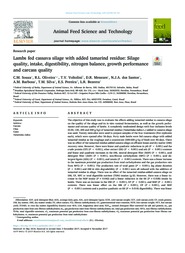Lambs fed cassava silage with added tamarind residue: silage quality, intake, digestibility, nitrogen balance, growth performance and carcass quality.
Lambs fed cassava silage with added tamarind residue: silage quality, intake, digestibility, nitrogen balance, growth performance and carcass quality.
Author(s): SOUZA, C. M.; OLIVEIRA, R. L.; VOLTOLINI, T. V.; MENEZES, D. R.; SANTOS, N. J. A.; BARBOSA, A. M.; SILVA, T. M.; PEREIRA, E. S.; BEZERRA, L. R.
Summary: The objective of this study was to evaluate the effects adding tamarind residue to cassava silage on the quality of the silage and its in vitro ruminal fermentation, as well as the growth performance and carcass quality of lambs. A completely randomized design with four inclusion levels (0.00, 100, 200 and 300 g/kg) of tamarind residue (Tamarindus indica L.) added to cassava silage was used. Twenty mini-silos were used to prepare samples of the four treatments (five replicates each), which were opened after 56 days. Forty male lambs were fed cassava silage with added tamarind residue as the roughage and a concentrate (500:500 g/kg of feed) over 85 days. There was no effect of the tamarind residue-added cassava silage on effluent losses and dry matter (DM) recovery rates. However, there were linear and quadratic reductions in pH (P < 0.001) and the crude protein (CP) (P < 0.001), ether extract (EE) (P < 0.001) and ash (P < 0.001) contents and linear and quadratic increases in the DM, neutral detergent fiber (NDF) (P < 0.001), acid detergent fiber (ADF) (P < 0.001), non-fibrous carbohydrate (NFC) (P < 0.001), acid detergent lignin (ADL) (P < 0.001), and tannin (P < 0.001) contents. There was a linear increase in the maximum potential gas production from total carbohydrates and the gas production rate from NFCs (P < 0.001). The production rate of total gases (P < 0.001), lag phase duration (P < 0.001) and DM in vitro degradability (P < 0.001) were all reduced with the addition of tamarind residue in silage. There was no effect of the tamarind residue-added cassava silage on DM, CP, NFC or total digestible nutrient (TDN) intakes (g/d). However, there was a linear increase in the NDF intake (P=0.042) and a linear reduction in the EE (P=0.038) intake by lambs. There was an increase in the DM (P < 0.001), CP (P < 0.001), and NDF (P < 0.001) contents. There was linear effect on the DM (P < 0.001), CP (P < 0.001), and NDF (P < 0.001) contents and a positive quadratic on EE (P=0.018) digestibility. There was linear increase in nitrogen (N) fecal excretion (P < 0.001) and a quadratic decrease in N urinary (P=0.018) excretion and N retention (P < 0.001). There was an increase in the hot and cold carcass weights and yields (P < 0.001) and in the Longissimus dorsi area (LDA) (P < 0.001) of the lambs. The addition of 300 g/kg tamarind residue to cassava silage is recommended because it reduces the production of gases and improves the DM content of the diet. In addition, this diet increases the DM in vitro digestibility and intake (DMI), N retention, hot and cold carcass yields, and LDA of lambs.
Publication year: 2018
Types of publication: Journal article
Unit: Embrapa Semi-arid Region
Observation
Some of Embrapa's publications are published as ePub files. To read them, use or download one of the following free software options to your computer or mobile device. Android: Google Play Books; IOS: iBooks; Windows and Linux: Calibre.
Access other publications
Access the Agricultural Research Database (BDPA) to consult Embrapa's full library collection and records.
Visit Embrapa Bookstore to purchase books and other publications sold by Embrapa.

